PF or EPF Withdrawal – How to Claim EPF Amount Online
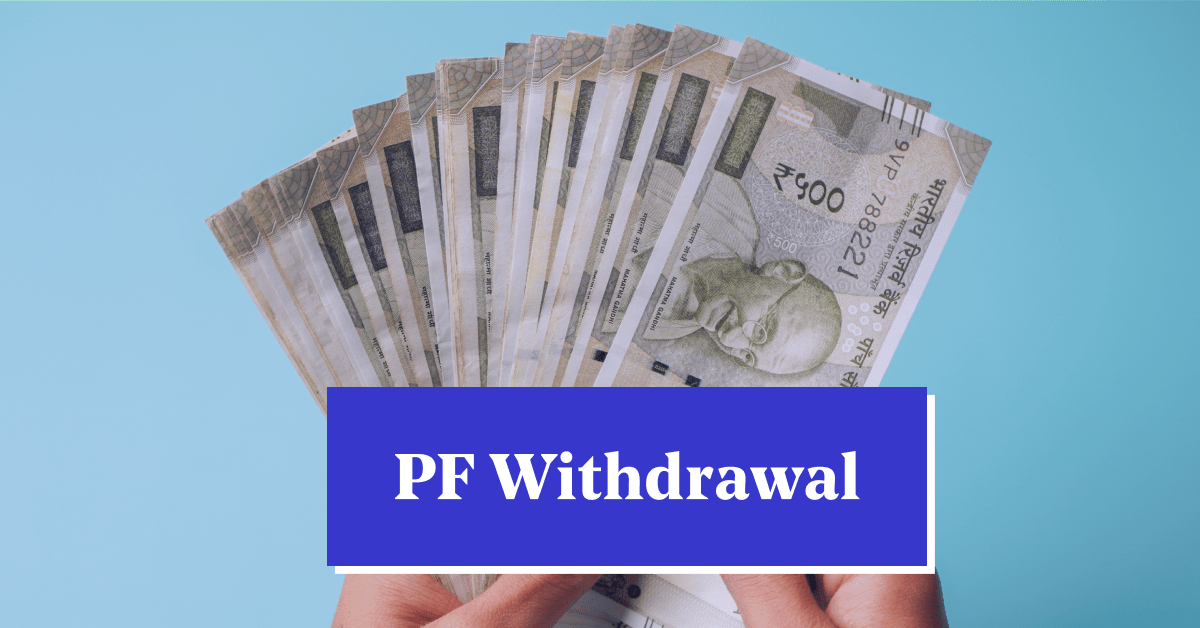
Planning your financial future includes understanding how to access your hard-earned Provident Fund (PF) savings when needed. In this comprehensive blog, we delve into the intricacies of the online EPF withdrawal procedure, guiding you through the PF withdrawal online process, eligibility criteria, different withdrawal types, tax implications, and smart management tips.
Moreover, learn how to make informed decisions while unlocking your PF funds to meet various life goals with confidence.
What is a PF Account?
The PF full form is Provident Fund (PF). A PF account is a dedicated savings scheme in which both employers and employees make regular contributions. It is a long-term savings plan created to give workers financial security throughout retirement.
The EPFO manages the PF account and contributions, overseeing the implementation and adherence to the rules and regulations related to Provident Fund contributions and withdrawals. The PF account serves as a vital financial instrument for long-term savings and retirement planning for employees.
How Does it Work?
Here is how a Provident Fund (PF) account operates:
- Both the employee and employer contribute 12% of the employee’s basic salary and dearness allowance to the EPF.
- Contributions are deposited with the Employees’ Provident Fund Organisation (EPFO).
- The EPFO invests the contributions in various financial instruments like government bonds and equities.
- Interest earned on investments is credited to employees’ PF accounts.
- Employees can withdraw their PF contributions after a specific period, subject to certain conditions.
How to Withdraw PF Amount Online?
Here is the step-by-step PF withdrawal online procedure:
Step-by-Step Guide to Withdraw PF Amount
- Check Eligibility: Ensure that you meet the criteria for withdrawal, such as unemployment, retirement, or specific emergencies.
- Complete KYC: Update and verify your KYC details with your employer or PF office.
- Fill out the PF Withdrawal Application: Obtain the appropriate withdrawal form. This includes EPF withdrawal form 31, EPF withdrawal form 19 or Form 10C from your employer or online portal.
- Provide Bank Details: Submit your bank account details for direct credit of the withdrawn amount.
- Submit the Form: Fill out the form, attach the required documents, and submit it to your employer or PF office.
Forms & Documents Required for EPF Withdrawal
The documents typically required for PF withdrawal online include:
- Identity Proof: Aadhaar card, PAN card, passport, or voter ID.
- Address Proof: Aadhaar card, passport, utility bill, or voter ID.
- Bank Details: Cancelled cheque or bank statement.
- PF Account Details: UAN (Universal Account Number), PF account number, and details of previous withdrawals, if any.
How to Claim EPF Online?
EPFO (Employees’ Provident Fund Organization) provides an online claim facility to its members for easy processing of various types of EPF (Employee Provident Fund) claims. The online claim process is designed to simplify and expedite the withdrawal of PF funds for eligible members. Here’s a step-by-step guide to the EPFO online claim process:
1. Log in to the Member Portal to apply for EPFO Claim Online.
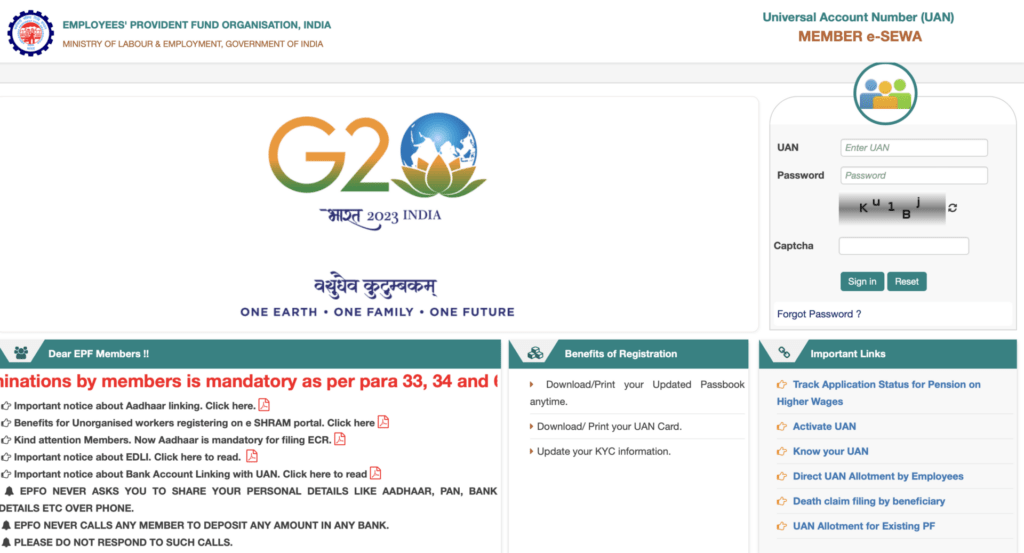
2. Access ‘Online Services’ for PF Claim Online
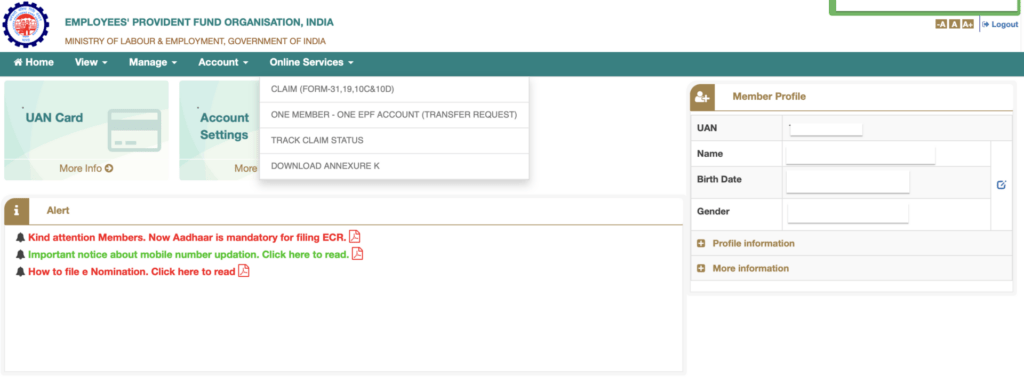
3. Verify KYC Details for EPF Claim Online. This step is essential for a successful online claim process.
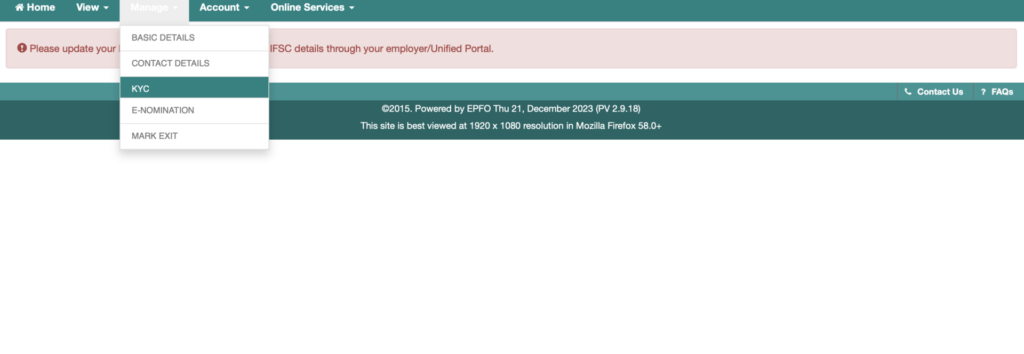
4. Choose the Appropriate Claim. Select the type of claim you want to make from the available options, such as PF withdrawal online (Form-19), pension withdrawal (Form-10C), or partial withdrawal (Form-31).
5. Enter the Last 4 Digits of the Bank Account and ‘verify’.
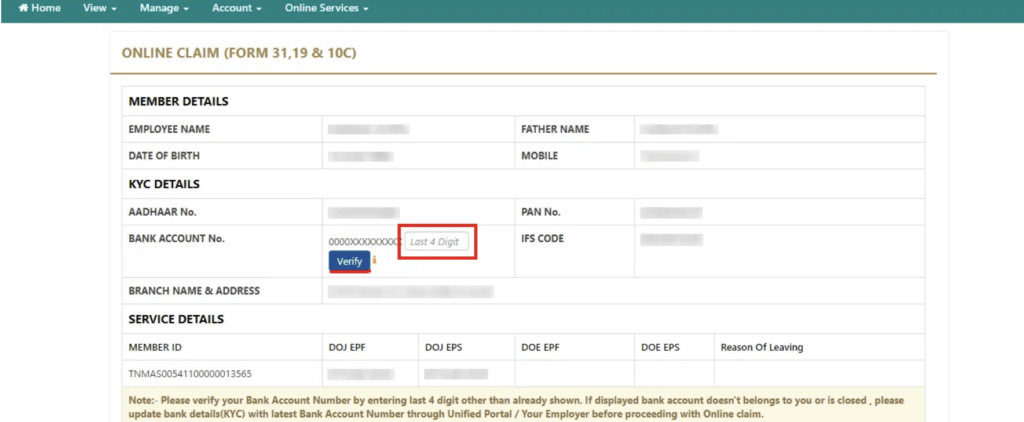
6. Undertaking will Pop Up. Select ‘Yes’ for your online certificate of undertaking.
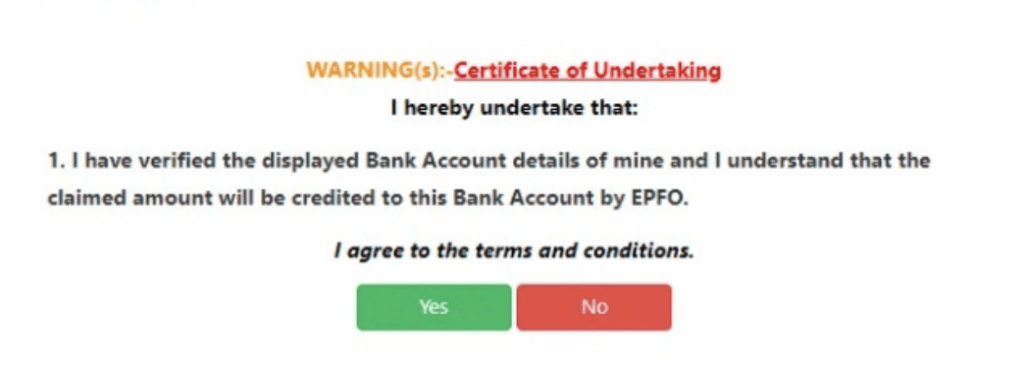
7. Click on ‘Online Claim’ for EPF Withdrawal. The online PF withdrawal request will be sent to your employer for verification.
8. In the ‘I want to apply for‘ drop-down menu, please select ‘Only PF Withdrawal (Form-19)‘.
9. Choose the correct purpose under the ‘Purpose for which advance is required’ option and enter the required amount in the next step.
10. Upload & submit the scanned documents
11. You can track the status of your claim online by logging into the EPFO member portal and going to the ‘Track Claim Status’ section.
Reasons for Online PF Withdrawal Process
It’s important to note that while EPF withdrawal offers financial flexibility during challenging times, premature withdrawals can impact long-term retirement savings. Here are the reasons for which people choose to withdraw PF money from the PF account:
- Retirement: Many individuals opt for EPF withdrawal after their retirement to utilize the accumulated funds as a source of regular income during their post-employment years.
- Unemployment or Job Loss: In case of job loss or unemployment, the EPFO withdrawal can provide financial support until a new job is secured.
- Medical Emergencies: PF withdrawal may be sought to cover medical expenses during critical health situations for the employee or their immediate family members.
- Home Loan Repayment: EPF partial withdrawal can be done as well. This helps in partial PF withdrawal for home loan repayment, helping employees manage their housing-related financial commitments.
- Education or Marriage Expenses: Employees may choose to withdraw PF to meet significant life milestones such as financing higher education or marriage expenses for themselves or their children.
EPF Withdrawal Limit: How Much Can You Withdraw?
The EPF withdrawal amount has its own limitations, therefore, let’s have a look at the epf withdrawal process limitations down below:
| Purpose of EPF Withdrawal | EPF Withdrawal Limit |
|---|---|
| Medical Emergency | Total corpus or six times the monthly salary- whichever is lower |
| Wedding | 50% of the total EPF contribution till date |
| Repayment of Home Loan | Upto 90% of the total EPF corpus |
| Home Renovation | 12 times the monthly salary |
| Unemployment | 75% after 1 month of unemployment, 25% after 2nd month of unemployment |
| Retirement | Total corpus |
How to Withdraw Your EPF Without UAN?
To withdraw your EPF without UAN, you can follow these steps:
- Download the Composite Claim Form (Non-Aadhaar) from the EPFO website or the nearest PF office.
- Fill out the form with all the required details, including your name, father’s name, date of birth, PAN number, bank account number, and IFSC code.
- Get the form attested by your employer or a gazetted officer.
- Submit the form to the jurisdictional EPFO office along with the following documents:
- Copy of your PAN card
- Copy of your Aadhaar card (if available)
- Copy of your bank statement showing your bank account number and IFSC code
- Once your claim is processed, the EPFO will credit the amount to your bank account within 30 days.
Different Types of PF Withdrawals
Here are the different types of Provident Fund Withdrawals:
- Full Withdrawal: Employees are eligible for a EPF full withdrawal of their Provident Fund (PF) balance under certain circumstances, such as retirement, permanent migration abroad, or when they have remained unemployed for two months or more.
- Partial Withdrawal: Partial withdrawals are permitted for specific purposes while the employee is still employed. Common reasons for partial withdrawal include medical emergencies, higher education expenses, marriage, purchasing or constructing a house, and home loan repayments.
- Advance for Illness: Employees can apply for an advance from their PF account in case of a medical emergency or illness, either for themselves, their spouse, children, or dependent parents.
- Advances during Unemployment: If an employee has lost their job and remains unemployed for more than one month, they can apply for a non-refundable advance from their PF account.
- Advances for Home Loan Repayment: Employees can withdraw a portion of their PF savings to repay an outstanding home loan, provided they meet the specific criteria set by the EPFO.
- Advances for Renovation/Alteration of House: Employees can avail of a partial withdrawal for renovating or altering their existing residential property.
PF Withdrawal Rules and Guidelines
By adhering to the EPF withdrawal rules and guidelines and using these provisions judiciously, you can strike a balance between addressing immediate financial needs and securing your future retirement goals. Here are the rules and guidelines that you need to follow:
- PF Withdrawal Before Retirement Age: Making premature withdrawals from your Provident Fund (PF) is generally discouraged. However, certain situations like unemployment or medical emergencies may qualify for partial or complete withdrawal, subject to specific conditions and limitations.
- Withdrawal After Retirement Age: Upon reaching retirement age, you can opt for full withdrawal of your PF savings. This provides a lump-sum amount to support your post-retirement life and fulfil your financial needs.
- Special Provisions for Early Withdrawal: In certain circumstances like purchasing a house, funding education, or marriage expenses, you may be eligible for partial withdrawals before retirement age, provided you meet the prescribed criteria.
- Impact on Retirement Savings and Future Planning: Withdrawing from PF before the intended retirement age can significantly reduce your retirement corpus, affecting your financial security during your golden years. It’s crucial to carefully assess the implications on your long-term financial planning before making any withdrawals.
Advantages and Disadvantages of PF Withdrawal
Here are the benefits and potential risks of EPF withdrawal:
- Benefits of Accessing PF Funds: Withdrawing from your Provident Fund (PF) can provide much-needed financial support during emergencies, major life events, or to meet immediate financial obligations. It offers the flexibility to utilize the accumulated savings for various purposes.
- Potential Risks and Consequences: While PF withdrawal may seem like an easy solution, it comes with potential downsides. Premature withdrawals can significantly impact your retirement corpus and future financial security. Additionally, withdrawing before the completion of the mandatory period can lead to tax implications and loss of interest earnings.
- Alternatives to PF Withdrawal: Instead of withdrawing from your PF, consider exploring other options like taking a loan against your PF balance or availing partial withdrawals for specific purposes allowed under EPF rules. This way, you can address your urgent needs without compromising the long-term benefits of your PF savings.
Tips for Smart PF Management
To ensure a secure financial future and reap the rewards of a well-managed PF account during your retirement years, follow these steps:
- Be Consistent with Contributions: Regularly contribute to your Provident Fund (PF) account to leverage the power of compounding and grow your retirement corpus steadily. Avoid breaks in contributions to maintain an active PF account and maximize its potential.
- Explore PF Transfer Options: When changing jobs, consider transferring your PF balance to the new employer’s PF account or an Individual PF Account (UAN). This consolidation helps retain accumulated interest and benefits while simplifying PF management.
- Maximize PF Contributions: Take advantage of the Voluntary Provident Fund (VPF) to make additional contributions beyond the mandatory percentage (usually 12% of basic salary). Boosting your contributions can lead to better returns and avail of tax benefits available under the EPF scheme.
PF Withdrawal and Taxation
Here is what you need to know about EPF Withdrawal and taxation:
Tax on PF Contributions and Interest
Contributions made to the Employee Provident Fund (EPF) are eligible for tax deductions under Section 80C of the Income Tax Act. Both the employee’s and employer’s contributions up to a certain limit are exempt from taxation. Moreover, the interest earned on the PF balance is also tax-free.
PF Withdrawal Tax Treatment
The taxation of PF withdrawals depends on the tenure of continuous employment. If an individual withdraws their PF balance after five years of uninterrupted service, the withdrawal is tax-free. However, if the withdrawal occurs before completing five years of service, it is subject to taxation.
Tax-Saving Opportunities and Exemptions
To avail tax benefits, many individuals opt to transfer their PF balance to a tax-saving scheme like the Employees’ Provident Fund Organisation’s (EPFO) Voluntary Provident Fund (VPF) or a Public Provident Fund (PPF) account. These options offer similar tax benefits as EPF, making them attractive for long-term tax-saving and wealth accumulation.
Common Mistakes to Avoid During PF Withdrawal
Here are some common mistakes that you should avoid during PF Withdrawal:
Premature PF Withdrawal and Its Impact
One of the most significant mistakes individuals make is withdrawing funds from their Provident Fund (PF) prematurely. Early withdrawals can drastically reduce the accumulated corpus, leaving inadequate savings for retirement. Resisting the temptation to withdraw funds for non-essential purposes allows your PF to grow over time, ensuring a more substantial retirement corpus.
Accurate Submission of Documents for PF Withdrawals
Incorrect or incomplete document submission can lead to delays and complications during the withdrawal process. Ensuring all necessary documents are provided accurately helps facilitate a smooth withdrawal experience. Commonly required documents include identification proof, bank details, and PF account information.
Compliance with PF Rules and Regulations
Failure to adhere to the rules and regulations set by the PF authorities can lead to withdrawal complications. Being aware of the withdrawal eligibility criteria, such as minimum service period requirements, valid reasons for withdrawal, and tax implications, is crucial. Meeting these criteria ensures your withdrawal application is processed without delays or rejections.
Impact of PF Withdrawal on Retirement Planning
PF withdrawal has a significant impact on retirement plans. Here is how:
Assessing the Effect of PF Withdrawal on Retirement Corpus
Withdrawing funds from your Provident Fund (PF) before retirement can significantly impact your retirement corpus. The amount withdrawn reduces the principal sum, potentially leading to a smaller pool of funds available during retirement. It is essential to consider the long-term consequences of early withdrawals and how they may affect your financial security during your post-retirement years.
Strategies to Maintain Retirement Savings
To maintain healthy retirement savings, it is crucial to explore alternative strategies instead of opting for premature PF withdrawals. Some strategies to consider include:
- Building a Separate Emergency Fund: Having a dedicated emergency fund can help cover unexpected expenses, reducing the need to dip into your PF.
- Opting for Partial Withdrawals: In certain circumstances, such as medical emergencies or purchasing a home, some PF schemes allow partial withdrawals. This way, you can address immediate needs without depleting your entire retirement fund.
- Increasing Contributions: Consider increasing your contributions to the PF account to build a more substantial retirement corpus over time.
- Exploring Other Investment Options: Diversify your investments and consider other retirement-focused schemes like Public Provident Fund (PPF), National Pension System (NPS), or mutual funds to bolster your retirement savings.
To Wrap It Up…
In conclusion, your PF is a powerful asset that can provide financial security during various life stages. You can easily withdraw money from EPF for a specific purpose or preserve it for the long haul. As you embark on your financial journey, use this newfound understanding to pave the way for a prosperous future. Make the most of your PF savings and take charge of your financial freedom with confidence!”
FAQs
No, withdrawal is restricted except under specific circumstances like retirement, unemployment, marriage, education, or medical emergencies.
You can check your PF balance on the EPFO member portal, UMANG app, through missed call or SMS services.
No, there is a PF withdrawal limit. Partial withdrawals are allowed for specific purposes and complete withdrawal is allowed only at retirement or after age 58.
Processing time varies, but online withdrawals may take 5-15 working days, while offline withdrawals can take 30-60 days or more.
You can withdraw EPF online for specific purposes like retirement, job loss, or financial emergencies. However, partial or full withdrawals have limitations based on eligibility criteria. Withdrawals can be made online using the UAN.
You can withdraw your EPF (Employees’ Provident Fund) under circumstances such as retirement, resignation, or unemployment. EPF withdrawal forms online are available or a streamlined withdrawal process.
All About Saving Schemes –
Saving Schemes 101, know how to invest in each of the below mentioned saving schemes, their returns, investment span, withdrawal process in simple steps –






